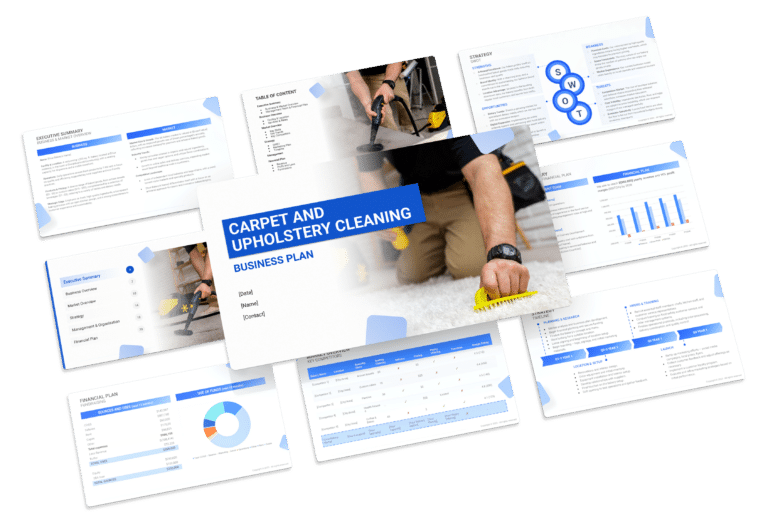Roofing/Siding Business Plan Template & PDF Example
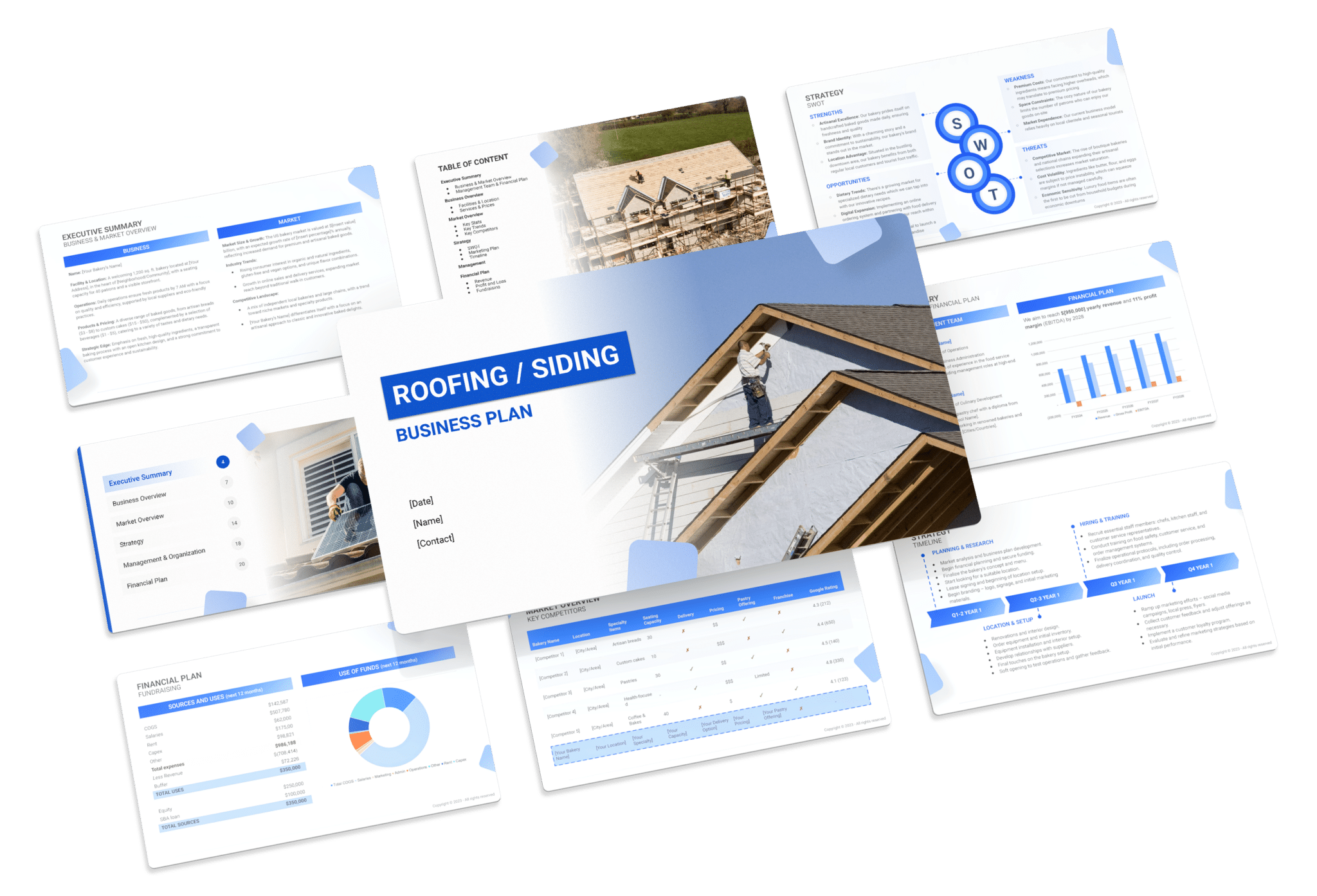
Creating a comprehensive business plan is crucial for launching and running a successful roofing/siding business. This plan serves as your roadmap, detailing your vision, operational strategies, and financial plan. It helps establish your roofing/siding business’s identity, navigate the competitive market, and secure funding for growth.
This article not only breaks down the critical components of a roofing/siding business plan, but also provides an example of a business plan to help you craft your own.
Whether you’re an experienced entrepreneur or new to the service industry, this guide, complete with a business plan example, lays the groundwork for turning your roofing/siding business concept into reality. Let’s dive in!
The Plan
Our roofing and siding business plan is systematically organized to incorporate all vital aspects essential for a comprehensive strategic blueprint. It specifies our company’s operational procedures, marketing approaches, market dynamics, competition analysis, executive team composition, and financial outlook.
- Executive Summary: Offers an overview of the Roofing and Siding business’s concept, market analysis, management team, and financial strategy.
- Business Overview: Provides detailed information on what the Roofing and Siding business offers and its operational model:
- Service List & Pricing: Lists the roofing and siding services provided, detailing customization options and pricing structure.
- Market Overview: Examines the roofing and siding industry landscape, highlighting competitors and the unique position of the Roofing and Siding business:
- Key Stats: Shares industry size, growth trends, and relevant statistics for the roofing and siding markets.
- Key Trends: Highlights recent trends in durable, energy-efficient materials and technological advancements in installation techniques.
- Key Competitors: Analyzes main competitors in the service area and differentiates the business from them.
- Strategy: Details how the Roofing and Siding business plans to achieve growth and attract clients:
- SWOT: Conducts a strengths, weaknesses, opportunities, and threats analysis specific to roofing and siding services.
- Marketing Plan: Outlines strategies for attracting new customers and retaining existing ones, including showcasing past projects and leveraging social media.
- Timeline: Sets out key milestones and objectives from business launch through the first year of operation.
- Management: Introduces the management team, detailing their experience in roofing and siding, project management, and roles within the business.
- Financial Plan: Forecasts the business’s 5-year financial performance, covering revenue projections, expense breakdowns, funding requirements, and financial statements (profit and loss, cash flow, balance sheet)
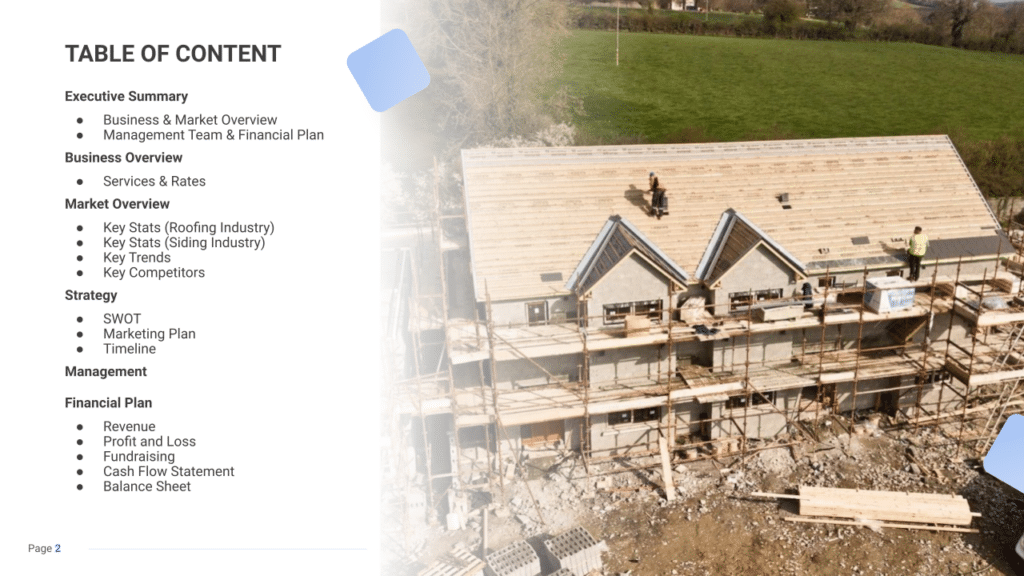
Executive Summary
The Executive Summary introduces your roofing and siding business plan, providing a succinct overview of your company and its services. It should outline your market positioning, the array of roofing and siding solutions you offer, its location, size, and a summary of daily operations.
This section should also delve into how your business will integrate into the local market, including the number of direct competitors in the area, identifying who they are, alongside your company’s unique selling points that set it apart from these competitors.
Moreover, this summary should encompass information about the management and co-founding team, detailing their roles and contributions to the company’s success.
Additionally, a summary of your financial projections, including revenue and profits over the next five years, should be included here to offer a transparent view of your company’s financial strategy.
Roofing/Siding Business Plan Executive Summary Example
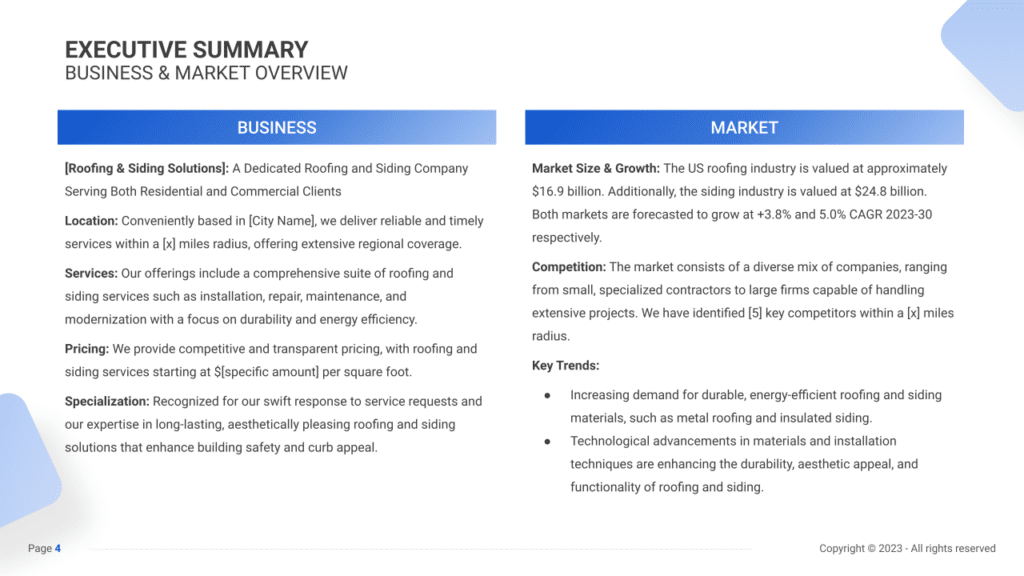
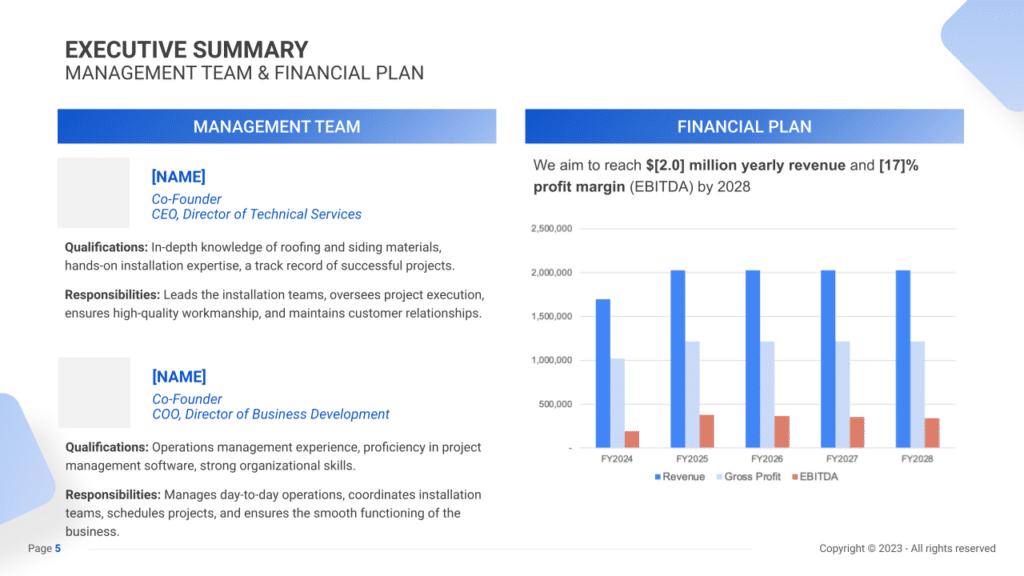
Business Overview
In presenting the business overview within the executive summary, clarity and brevity are paramount. Essential elements include the business name, location, and a concise glimpse into daily operations.
These details serve as an introduction to the business, setting the stage for its distinctive features. The unique selling proposition (USP) is the linchpin that differentiates the roofing/siding company from competitors. Whether it’s a focus on sustainability, superior craftsmanship, or a wide array of services, the USP should prominently feature in the executive summary, elucidating the unique value proposition offered to the market.
Example:
Introducing “[Roofing & Siding Solutions],” located in [City Name], dedicated to offering exemplary roofing and siding services to residential and commercial clients within a [x]-mile radius. Our key focus revolves around delivering durable, visually appealing solutions while prioritizing sustainability. The USP encompasses our swift response times coupled with expertise in sustainable, long-lasting installations, ensuring customer satisfaction and environmental responsibility.
Market Overview
A comprehensive market analysis involves understanding the market’s size, growth trends, and industry dynamics. This section should shed light on the roofing and siding industry, substantiated by relevant data such as market value and growth rates. Furthermore, it’s crucial to discuss evolving trends within the industry, whether it’s a shift towards environmentally friendly materials or innovative installation techniques, to position the business within this evolving landscape.
Equally vital is the competitive landscape analysis. The executive summary should identify primary competitors and articulate how the roofing/siding company distinguishes itself within this competitive environment. This is the opportunity to spotlight the company’s unique strengths, be they niche services, exceptional customer service, or innovative solutions, highlighting how the business stands out in the market.
Example:
Consider “[Roofing & Siding Solutions]” in the roofing and siding industry, with the US roofing industry’s $16.9 billion valuation and the siding industry’s $24.8 billion . Competing alongside established local firms and national companies, our unique positioning lies in delivering efficient, visually appealing solutions coupled with sustainable practices. This includes swift response times and a commitment to utilizing environmentally friendly materials, catering to an increasingly eco-conscious clientele.
Management Team
The proficiency and experience of the management team form a cornerstone of the business’s success. Highlighting the key qualifications and experiences of team members instills confidence in potential investors and partners.
This could encompass the tenure of co-founders or key team members in the industry, academic accomplishments, or professional training. Demonstrating the team’s expertise not only establishes credibility but also assures stakeholders of the company’s potential for success.
Example:
At “[Roofing & Siding Solutions],” co-founders [Name] and [Name] lead the team. [Name], with [years] of experience in [industry], brings invaluable expertise, while [Name], a [credential], contributes substantial insights from [relevant experience], enhancing the company’s overall management and innovation.
Financial Plan
The financial plan overview encapsulates the company’s fiscal goals and projections, encompassing revenue targets and profit margins, offering a comprehensive outlook on the business’s financial trajectory.
Example:
“[Roofing & Siding Solutions]” aims ambitiously for $2.0 million in yearly revenue and a [17]% EBITDA profit margin by 2028. Our financial strategy includes strategic investments in modern equipment and fostering customer-centricity, steering the business towards sustainable growth and community recognition within [timeframe].
Business Overview
Services & Rates
This slide should enumerate the variety of roofing and siding services your business offers, covering everything from installation, repairs, and replacements to specialized offerings like energy-efficient solutions or custom design work.
Your pricing strategy needs to be clearly articulated, reflecting the caliber of materials and craftsmanship you provide, tailored to the market segment you aim to serve. Emphasize any service bundles, maintenance plans, or warranties that offer additional value to your customers, fostering long-term relationships and enhancing customer retention.
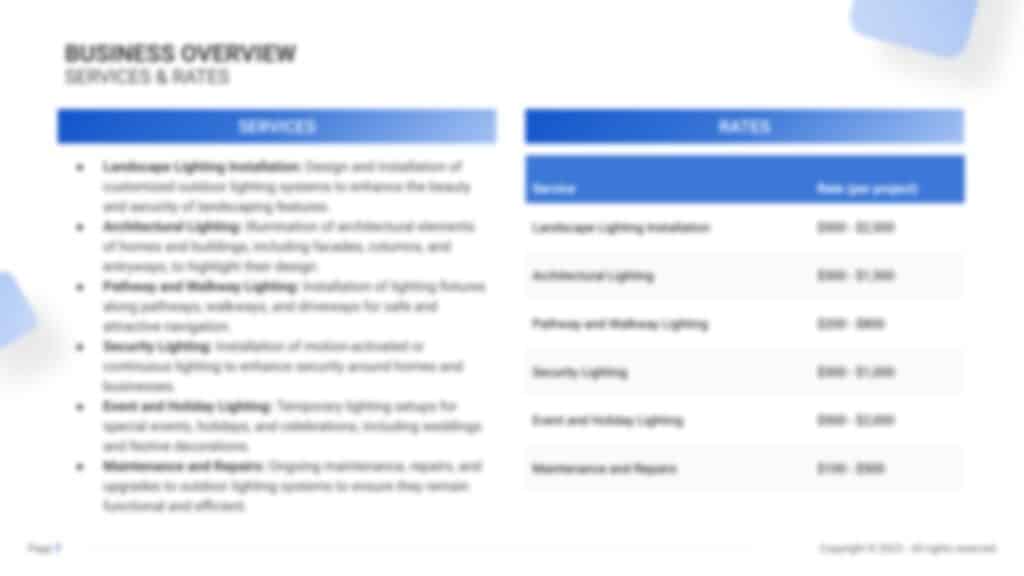
Market Overview

Industry size & growth
In the Market Overview of your Roofing and Siding business plan, begin by exploring the size of the roofing and siding industry and its growth potential. This analysis is essential for understanding the breadth of the market and pinpointing areas for potential expansion.
Key market trends
Next, delve into recent market trends, such as the growing consumer interest in durable, energy-efficient roofing and siding materials, the integration of green building practices, and the adoption of advanced technology for installation and repairs.
For instance, highlight the demand for services that provide long-lasting protection against weather elements, the increasing preference for eco-friendly and sustainable materials, and the innovative methods being used to enhance service delivery and customer satisfaction.
Competitive Landscape
A competitive analysis is not just a tool for gauging the position of your roofing/siding business in the market and its key competitors; it’s also a fundamental component of your business plan.
This analysis helps in identifying your roofing/siding’s unique selling points, essential for differentiating your business in a competitive market.
In addition, the competitive analysis is integral in laying a solid foundation for your business plan. By examining various operational aspects of your competitors, you gain valuable information that ensures your business plan is robust, informed, and tailored to succeed in the current market environment.
Identifying Your Competitors in the Roofing/Siding Industry
To comprehensively identify competitors within the roofing and siding industry, start by conducting a thorough assessment of the local landscape. This involves mapping out all potential competitors, ranging from established roofing and siding companies to newer entrants.
Direct competitors are those companies specifically known for their expertise in particular roofing materials, unique siding styles, or those prominently advertised in the area. These may include businesses that focus on metal roofing, asphalt shingles, cedar shakes, vinyl siding, and fiber cement siding, among others.
However, it’s equally important to recognize indirect competitors. These could be general contractors or home improvement companies offering roofing and siding services alongside their broader spectrum of offerings. Their inclusion in your analysis is vital, as they might cater to a similar customer base and influence market dynamics.
Leveraging various online tools and platforms like Google Maps, Yelp, Angie’s List, or HomeAdvisor provides a wealth of information. These platforms offer insights into customer reviews, ratings, and feedback about competitors’ strengths and weaknesses. Analyzing these reviews can reveal vital information about customer preferences, service quality, and areas where competitors excel or fall short.
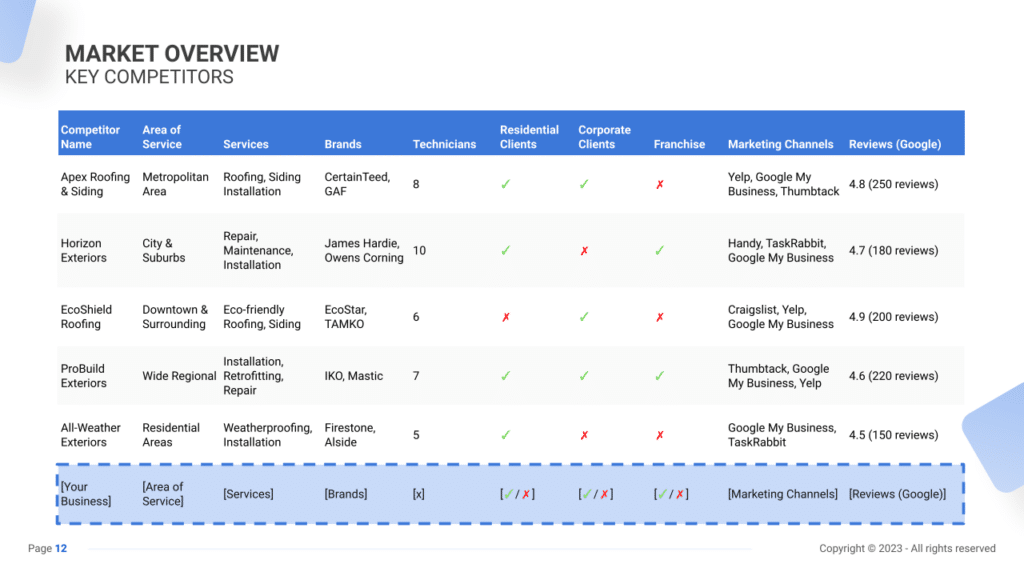
Roofing/Siding Business Competitors’ Strategies
When analyzing the strategies of your roofing and siding competitors, focus on several crucial aspects of their business operations:
- Services Offered: Evaluate the spectrum of services provided by competitors. Are they specialists in certain roofing materials or siding installations? Some competitors may offer comprehensive solutions, including roof repairs, full replacements, siding repairs, or complete siding installations.
- Technical Expertise: Assess the expertise and specialized techniques showcased by different companies. Businesses emphasizing eco-friendly roofing solutions or those employing cutting-edge siding technologies might attract a distinct clientele seeking sustainability or advanced product features.
- Pricing Models: Understand the pricing structures used by competitors to position themselves in the market. Compare your rates with theirs—are you competing in the budget-friendly segment or offering premium services akin to established firms?
- Marketing Approach: Examine how competitors market their services. Do they leverage digital marketing channels, testimonials, or community engagement to attract customers? Understanding their marketing strategies can help tailor your approach to effectively reach your target audience.
- Customer Satisfaction: Evaluate the overall customer experience provided by competitors. A company known for responsive customer service, timely project completion, or excellent post-installation support might hold a significant competitive advantage in the market.
What’s Your Business’s Value Proposition?
Define your roofing/siding business’s unique value proposition. Whether it’s expertise in a particular roofing material, a commitment to sustainable siding solutions, or exceptional customer service, highlighting this differentiation is crucial.
Identify market gaps through customer feedback and industry trends. For instance, if there’s an increasing demand for energy-efficient roofing solutions and few competitors are capitalizing on this, it presents an opportunity for your business to fill that void.
Consider the geographic and demographic factors. A business operating in urban areas might focus on large-scale commercial projects, whereas one situated in suburban locales could specialize in residential roofing renovations.
Strategy

SWOT
First, conduct a SWOT analysis for your Roofing and Siding business, identifying Strengths (such as high-quality materials and experienced installation teams), Weaknesses (including potential market saturation or seasonal fluctuations in demand), Opportunities (for instance, the growing demand for energy-efficient and sustainable roofing and siding solutions), and Threats (such as economic downturns that may impact construction and renovation spending).

Marketing Plan
Next, devise a marketing strategy that details how to attract and retain customers through direct marketing, seasonal promotions, a robust online presence, and participation in local home improvement events or shows. Highlight the importance of showcasing completed projects, customer testimonials, and the unique value proposition of your business to differentiate it from competitors.
Marketing Channels
Utilize diverse marketing channels to reach potential customers and increase brand visibility:
Digital Marketing
- Website and SEO: Develop a user-friendly website that showcases your portfolio, customer testimonials, educational content, and a blog section covering roofing and siding maintenance tips. Implement a robust search engine optimization (SEO) strategy to enhance your visibility in online searches.
- Social Media: Leverage social media platforms like LinkedIn, where you can share industry insights, completed projects, and engage with potential clients. Consider creating visually appealing content for platforms like Instagram and Facebook to showcase before-and-after project images, client stories, and informative videos about roofing and siding materials and processes.
- Email Marketing: Build an email subscriber list by offering valuable content, such as guides on roof maintenance or siding material comparisons, in exchange for email sign-ups. Regularly send newsletters with seasonal promotions, company updates, and educational content to nurture leads and stay top-of-mind with clients.
Local Advertising
- Direct Mail and Print: Distribute well-designed brochures, flyers, or postcards in local neighborhoods to create awareness about your services and special offers.
- Networking and Community Engagement: Participate in local events, sponsor community initiatives, or collaborate with real estate agents, home improvement stores, or local businesses for cross-promotional opportunities.
Promotional Activities
- Seasonal Promotions: Develop enticing seasonal offers tailored to the needs of your target audience. For instance, consider offering discounts or complimentary inspections during peak roofing or siding seasons. Promote these specials through various channels to attract potential clients.
- Referral Programs: Encourage existing customers to refer friends, family, or colleagues by offering incentives such as discounts on future services or a gift card for successful referrals. Create referral cards or digital codes that make it easy for customers to share and redeem rewards.

Sales Channels
Effectively manage sales channels to enhance revenue and customer satisfaction:
In-Person Sales Strategies
- Consultative Selling: Train your sales team to adopt a consultative approach. Focus on educating potential clients about different roofing and siding options, addressing their concerns, explaining the installation process, and recommending suitable solutions tailored to their needs.
- Upselling and Cross-Selling: During ongoing projects or consultations, recommend additional services or upgrades that complement the customer’s primary choice. This might include suggesting energy-efficient roofing options, enhanced insulation materials, or siding accessories that add value to their investment.
Online Sales Enhancements
- Online Quoting and Estimation Tools: Implement user-friendly tools on your website that allow potential clients to get estimates for roofing or siding projects.
- E-Commerce for Products: Sell roofing and siding materials or related products online, offering convenience to customers and an additional revenue stream.
Customer Retention Strategies
Implement strategies to foster loyalty and encourage repeat business:
- Maintenance Plans: Offer annual maintenance contracts or inspection services to existing clients. Emphasize the importance of regular maintenance for extending the lifespan of roofs and siding while ensuring their durability and functionality.
- Loyalty Programs: Develop a loyalty program where frequent customers can accumulate points or earn rewards for every service availed. Offer exclusive discounts, priority scheduling, or additional warranties for loyal clients, enhancing their satisfaction and encouraging repeat business.
Strategy Timeline
Lastly, outline a comprehensive timeline that marks key milestones for the launch of your Roofing and Siding business, from initial market research and business setup to launching marketing campaigns, building a customer base, and planning for future growth or diversification. This timeline should guide the business towards achieving its goals with precision and clarity.

Management
The Management section focuses on the roofing/siding business’s management and their direct roles in daily operations and strategic direction. This part is crucial for understanding who is responsible for making key decisions and driving the roofing/siding business towards its financial and operational goals.
For your roofing/siding business plan, list the core team members, their specific responsibilities, and how their expertise supports the business.


Financial Plan
The Financial Plan section is a comprehensive analysis of your financial projections for revenue, expenses, and profitability. It lays out your roofing/siding business’s approach to securing funding, managing cash flow, and achieving breakeven.
This section typically includes detailed forecasts for the first 5 years of operation, highlighting expected revenue, operating costs and capital expenditures.
For your roofing/siding business plan, provide a snapshot of your financial statement (profit and loss, balance sheet, cash flow statement), as well as your key assumptions (e.g. number of customers and prices, expenses, etc.).
Make sure to cover here
_ Profit and Loss
_ Cash Flow Statement
_ Balance Sheet
_ Use of Funds






